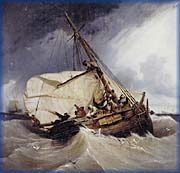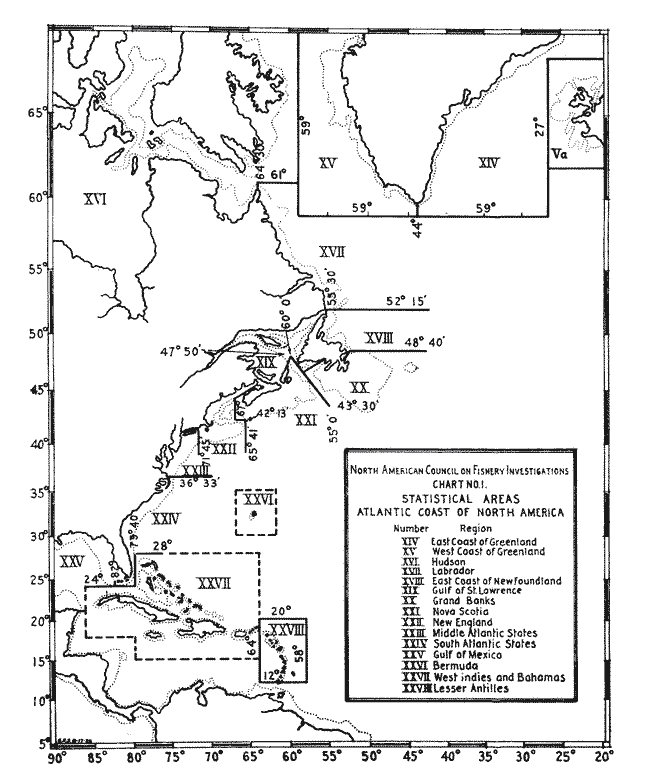Thus began in the 1490s, the discovery of the New World and the discovery of the fish resources of the Northwest Atlantic. The enormous cod stocks of the Northwest Atlantic in fact opened up a great source of food and wealth for Europeans. Historic records show that the Portuguese, French and Spanish, followed by the English were the first to engage in the Newfoundland fishery.
From 1500 to 1950
The first major fisheries of the east coast of North America predate the formation of ICNAF by 425 years. Starting in the late 1500s, France and Portugal, followed later by Spain and England developed the first long distant fleets fishing for cod on the Grand Banks off Newfoundland (Innis, 1978, Lear 1998). The early fishery based almost exclusively on cod, was recording as much as 30 000 – 40 000 tons by the end of the century. Much of that early effort was carried out by long lining; trawling came much later. To the south in USA waters, commercial long lining began primarily near shore soon after the first colonists arrived in New England in the early-1600s. Beginning in the mid-1700s, fishing expanded, reaching further offshore to the Georges Bank. Major fisheries developed to include other groundfish. The fishing areas expanded from the Newfoundland waters to the New England waters and eventually expanded to include all the fishing areas of the Northwest Atlantic. Catches during this time had increased to well over 100 000 tons annually.
The initial interests in management was noted in US records in 1653, when a minister from Massachusetts urged local communities and English businessmen to invest in the infant fishing industry. That same year, the General Court of Massachusetts Bay established a fishery management commission, and several years later, exempted fishing vessels and equipment from taxation. New laws were enacted to improve the quality of marketed fish and close the cod and mackerel fisheries during the spawning season. These policies remained in place throughout the colonial period.

Through the next 200 years the fishing industry thrived with many periods of low and high production. Associated with the industry, coastal communities developed along the eastern seaboard.
The 1800s brought significant technological changes to the fisheries along with increased landings. By the end of the century annual catches were over 0.5 million tons. Even early on, there was a realization that the fishery resources were not finite and that increasing exploitation was having a negative effect on the stocks. Hennemuth and Rockwell (1987) reported that in the late-1860s, New England fishermen raised concerns about declines in the abundance of some of the near-shore species prompting the first attempt to understand the nature of the fish populations and effects of exploitation. The imposition of closures by the General Court of Massachusetts Bay on cod and mackerel fisheries during the spawning season was the earliest recorded attempt at management.
In 1871, the US Congress created the Fish Commission and a temporary fishery research station was established in 1875 in Woods Hole Massachusetts, made permanent in 1885 (Galtsoff, 1962). In Canada, a Board of Management and the first marine biological research station were established in 1898, a permanent facility established in 1908 in St. Andrews, New Brunswick (Parsons, 1993, Trippel 2011). Both countries continued to develop national programs and departments for the purpose of managing fisheries in their territorial (coastal) waters. Off Greenland, cod had been fished since the 1800s, mainly by non-Greenland vessels prior to the 1900s (Horsted 2000). It was not until 1910 that fishery statistics were collected (and published by ICES). Management of the fisheries there started under ICNAF. Greenland, as an integrated part of Danish attended ICNAF as part of the Denmark delegation.

Concern about the effects of fishing on stocks was a primary motivation for establishing the International Council for the Exploration of the Sea (ICES) in 1902 (Went, 1972) but that organization dealt with research on the living resources and focused on the northeast Atlantic. There was no management mandate.
Initial attempts at fisheries management comprised the establishment of hatcheries designed to enhance commercially exploited stocks. In 1919, a minimum mesh size set for cod trap nets in Newfoundland constituted one of the earliest management measures there (Halliday and Pinhorn 1996). Closed areas were employed in Canada to minimize gear conflicts but the only action that effectively reduced exploitation was a limit placed on the number of trawlers (an emerging technology) in the 1920s and 1930s.